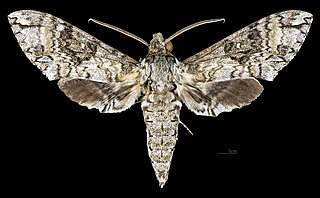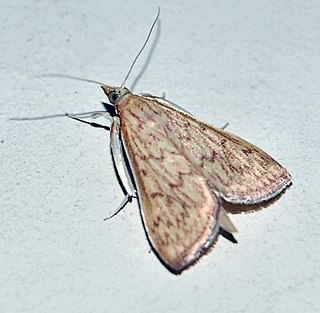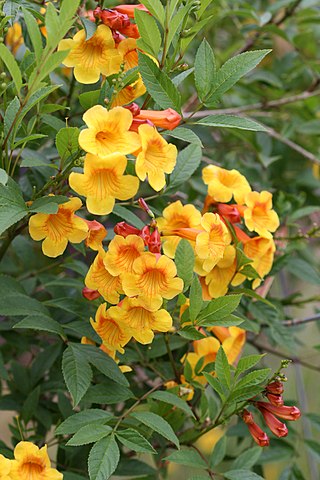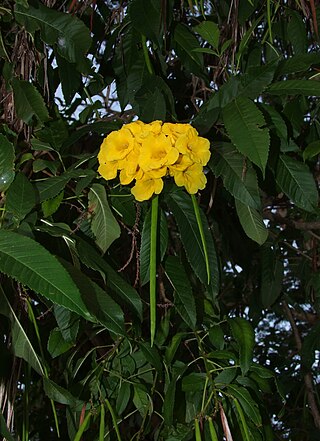
Bolivia, officially the Plurinational State of Bolivia, is a landlocked country located in western-central South America. It is bordered by Brazil to the north and east, Paraguay to the southeast, Argentina to the south, Chile to the southwest, and Peru to the west. The seat of government and administrative capital is La Paz, which contains the executive, legislative, and electoral branches of government, while the constitutional capital is Sucre, the seat of the judiciary. The largest city and principal industrial center is Santa Cruz de la Sierra, located on the Llanos Orientales, a mostly flat region in the east of the country.

Tecoma is a suburb in Melbourne, Victoria, Australia, 35 km east from Melbourne's central business district and 1 km west of Belgrave, located within the Shire of Yarra Ranges local government area. Tecoma recorded a population of 2,064 at the 2021 census.

Tecoma railway station is located on the Belgrave line in Victoria, Australia. It serves the eastern Melbourne suburb of Tecoma, and opened on 1 December 1924.

Tecoma is a genus of seven species of shrubs or small trees in the trumpet vine family, Bignoniaceae. They are native to the Americas, ranging from the extreme southern United States through Central America and the Antilles south through Andean South America to northern Argentina. The generic name is derived from the Nahuatl word tecomaxochitl, which was applied by the indigenous peoples of Mexico to plants with tubular flowers. Trumpetbush is a common name for plants in this genus.

Pandorea is a genus of nine species of flowering plants in the family Bignoniaceae and is native to Australia, Malesia, New Guinea and New Caledonia. Plants in the genus Pandorea are mostly woody climbers with imparipinnate leaves arranged in opposite pairs, flowers in groups with tube-shaped flowers, and winged seeds.

Manduca brontes is a species of moth in the family Sphingidae first described by Dru Drury in 1773. It is known from Jamaica, Cuba, Haiti, Puerto Rico, the Cayman Islands, the Dominican Republic and Suriname.

Manduca florestan, the Florestan sphinx, is a moth of the family Sphingidae. The species was first described by Caspar Stoll in 1782.

Tecomaria capensis, the Cape honeysuckle, is a species of flowering plant in the family Bignoniaceae, native to southern Africa. Despite its common name, it is not closely related to the true honeysuckle.

Tecoma stans is a species of flowering perennial shrub in the trumpet vine family, Bignoniaceae, that is native to the Americas. Common names include yellow trumpetbush, yellow bells, yellow elder, ginger Thomas. Tecoma stans is the official flower of the United States Virgin Islands and the floral emblem of The Bahamas.

The white-bellied sunbird, also known as the white-breasted sunbird, is a species of bird in the family Nectariniidae. It is found in Angola, Botswana, Democratic Republic of the Congo, Eswatini, Malawi, Mozambique, Namibia, South Africa, Tanzania, Zambia, and Zimbabwe.

Antigastra catalaunalis is a species of moth of the family Crambidae. The species was first described by Philogène Auguste Joseph Duponchel in 1833. It is endemic to tropical and subtropical areas, but is also found in other areas due to its migratory nature.

The Bolivian river dolphin is a species of the genus Inia.

Pandorea doratoxylon is a species of woody vine in the family Bignoniaceae and is endemic to Australia. The species was first formally described in 1927 by John McConnell Black who gave it the name Tecoma doratoxylon in Transactions and Proceedings of the Royal Society of South Australia. In 1937, Black changed the name to Pandorea doratoxylon.
Tecoma is a genus of 14 species of shrubs or small trees. Tecoma may also refer to the following:
Zebronia phenice is a moth in the family Crambidae. It was described by Stoll in 1782. It is found in Cameroon, Mayotte, the Democratic Republic of Congo, Equatorial Guinea, Ethiopia, Gabon, Ghana, Ivory Coast, Kenya, La Réunion, Madagascar, Mauritius, Mozambique, Nigeria, Senegal, Sierra Leone, South Africa, Tanzania, Gambia, Uganda, Zambia and Zimbabwe.

Tecoma × smithii, "Orange Bells", is a hybrid flowering plant in the genus Tecoma. It was first described by W. Watson in London, 1893. It is a shrub growing to 2.4–3.6 m (8–12 ft) in height.

Tecoma fulva is a species of flowering plant native to South America. In the past, several species have been named, which are more recently considered to be subspecies.

Tecoma castanifolia is a species of flowering plant native to Ecuador and Peru. Unlike some other Tecoma species, the leaves are simple.
Tecoma rosifolia is a species of flowering plant native to Peru. It is thought to be closely related to T. tenuiflora, and hybridizes with T. stans.
Tecoma tenuiflora is a species of flowering plants native to Bolivia and Argentina. It is thought to be closely related to T. rosifolia, and hybridizes with T. stans and T. beckii.















